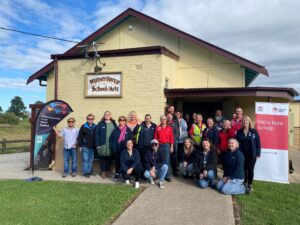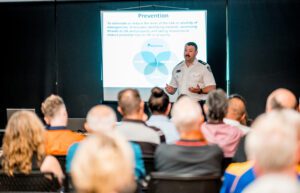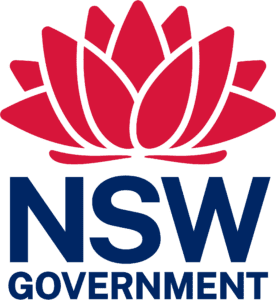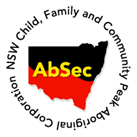Emergency Management Governance
NSW has a well-defined and documented system for responding to emergencies in NSW, involving numerous government agencies and some non-government organisations. The purpose of this system is outlined in the State Emergency Management Plan (EMPLAN)to ‘provide clarity as to command and control, roles and coordination of functions in emergency management across all levels’.
- Emergency Management governance arrangements are outlined in State, Regional and Local level plans. For an overview of Disaster Management Plans relevant to the NGO sector, see Emergency Management Terminology.
- The NSW Reconstruction Authority is responsible for the NSW State Disaster Mitigation Plan and the NSW Recovery Plan.
Quick links for information on this page:
Why is community connection to Emergency Management important?
How do place-based NGOs engage effectively with Emergency Management governance?
Evacuation Centres
Evacuation Centre locations
- The State Emergency Management Plan (EMPLAN) outlines that evacuation centre sites are determined by Local Emergency Management Committees prior to an event. A decision to open an evacuation centre is made by the person in charge of the incident or emergency, and communicated to Department of Communities and Justice (DCJ), which is responsible for opening and staffing evacuation centres.
Evacuation Centre Management
- Evacuation Centre Management is the responsibility of the Department of Communities and Justice (DCJ). The NSW State Emergency Plan Evacuation Management Guidelines outlines how Evacuation Centres are managed.
- Once identified and activated by the Combat Agency or EOCON, the establishment and management of evacuation centres is the responsibility of the Welfare Services Functional Area (WSFA).
- The Welfare Services Functional Area Supporting Plan details the control and coordination arrangements for managing evacuation centres and the provision of welfare services.
- To ensure the effective operation of an evacuation centre, evacuation plans should detail arrangements for communication between service providers and include contingencies to manage issues that may arise during the operation of an evacuation centre. This may include:
- sources for goods and services that will be required for the duration of the evacuation centre such as food, hygiene, pharmaceutical and other necessary supplies
- health, mental health and welfare services
- supporting the needs of people with disability
- security and safety
- Remotely Managed Evacuation Centres - the NSW State Emergency Plan Evacuation Management Guidelines (automatic download) also define Remotely Managed Evacuation Centres
- Remotely managed evacuation centres are operated under the direction of the Welfare Services Functional Area (WSFA) and are remotely established and staffed by other approved organisations.
- These centres are activated when WSFA are unable to attend to or establish an evacuation centre due to the inability to access the location when quick isolation occurs. The centre is remotely managed by a DCJ Evacuation Centre Manager until DCJ staff can gain access.
- The activation of these centres occurs by the authority of the Combat Agency or EOCON within the normal emergency management arrangements.
- A number of NGOs (e.g. Red Cross, Anglicare, Salvos, 54 Reasons) are formally engaged to provide welfare support at Evacuation Centres. Their roles are outlined in the Welfare Services Functional Area Supporting Plan, updated in 2023.
- Pre-event planning and engagement is required to identify areas with large Aboriginal or CALD communities where English language proficiency is limited and support cultural safety and inclusive service delivery.
- For more information on volunteering in evacuation centres:
- read Evacuation Centre Volunteer Roles
- watch the YouTube clip 3 Questions about Disaster Recovery produced by Anglicare (9 Minutes: The Role of an Evac Centre)
Recovery Centres
Recovery Centres are coordinated by Council in partnership with NSW Reconstruction Authority. Detail on the operation of Recovery Centres is available in the NSW Recovery Plan, updated in 2023.
A Recovery Centre includes a range of government and non-government agencies to provide centralised access to advice and services including:
|  Hawkesbury Disaster Recovery Team (Peppercorn Services) |
Why is community connection to Emergency Management important?
During a disaster, community responses, including support provided by place-based NGOs, and emergency responses delivered by formal Emergency Management agencies may run in parallels with little or no connection.
Place-based NGOs have knowledge and expertise working with local communities, especially those experiencing disadvantage. They often have established community and communication networks. These networks and expertise can be crucial to effective emergency management.
Research Report
The report Community Sector Involvement in Disaster Management has been published by Southern Cross University, highlighting the critical role NGO services played in the Northern Rivers floods and the need for greater community sector involvement in disaster preparedness and planning. The research was undertaken in collaboration with NCOSS and place-based services active in the Northern Rivers flood response and recovery.
The report includes a cross-jurisdiction analysis of Australian and international disaster management practices, a review of examples of how NGOs have been working with government in disaster management in Australian jurisdictions and overseas, and the results of a series of focus groups held with local NGOs across the Northern Rivers.
Vulnerability literacy
Vulnerability literacy is education and awareness-raising with Emergency Management and Government agencies to enable the identification and understanding of socio-economic vulnerability in the disaster space. Effective vulnerability literacy includes a corresponding process of identifying strengths and solutions that exist in communities.
For examples of how social service NGOs have developed Vulnerability Literacy in the agencies they work with, see Case Study_Influencing Emergency Management governance.
How do place-based NGOs engage effectively with Emergency Management governance?
How to influence Emergency Management governanceDevelop an understanding of formal Emergency Management governance
Engaging with Emergency Management will differ across regions, depending on: |  Hawkesbury Community Sector Disaster Capability Team "Dismiss the Myths" NGO & Emergency Management Workshop |
- formal Emergency Management governance structures and local understandings of working with the social service NGO sector
- the capacity and capability of local social service NGOs to engage with Emergency Management
Social service NGOs, consider:
- Coordination of place-based social service NGOs – Who does what in emergencies? Who speaks for the local sector?
- Local social service NGOs need to provide clear messaging to Emergency Management – What we offer. How we work with you.
- Develop clear pathways for ongoing, two-way communication and action – Council Community Resilience Networks, sector interagency groups, other.
Case Study_Influencing Emergency Management governance
Community Resilience Networks (CRNs)
Many Councils have established Community Resilience Networks (CRN) which bring together organisations that are not traditionally represented on the Local Emergency Management Committee (LEMC) or recovery committee, enabling participation of community service organisations, business networks, government and others in recovery planning and resilience building for their communities.
Singleton Council have produced a short video explaining how their Community Resilience Network operates.
The NCOSS Disaster Support webpages are part of the Community Sector Disaster Capability Project. The Project, a partnership between NCOSS, AbSec and the Local Community Services Association (LCSA), was jointly funded by the Australian and NSW Governments under the National Partnership Agreement on Disaster Risk Reduction, through a Disaster Risk Reduction Fund grant. The CSDC Project was completed in June 2024.
 |  |  |  |
